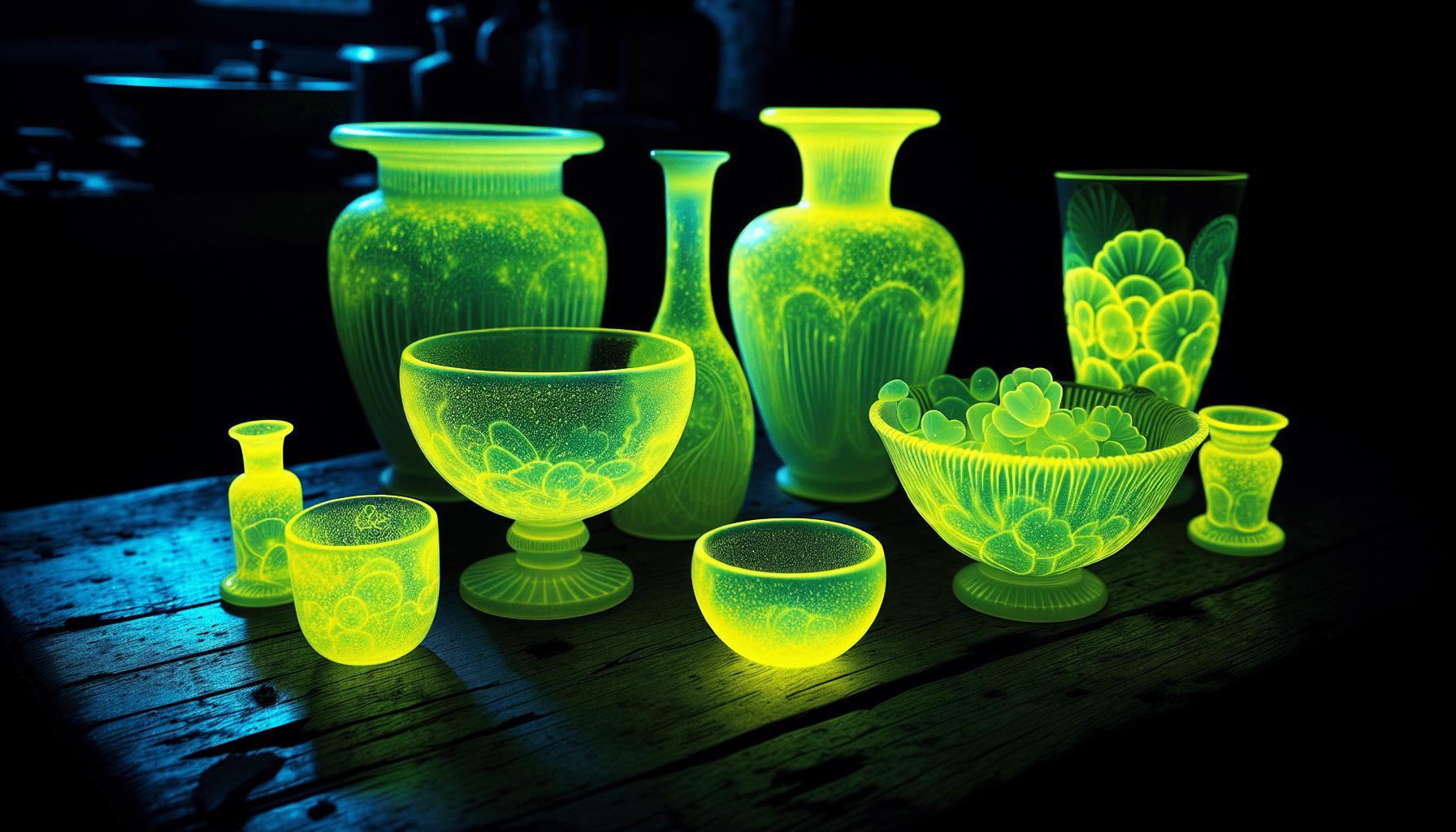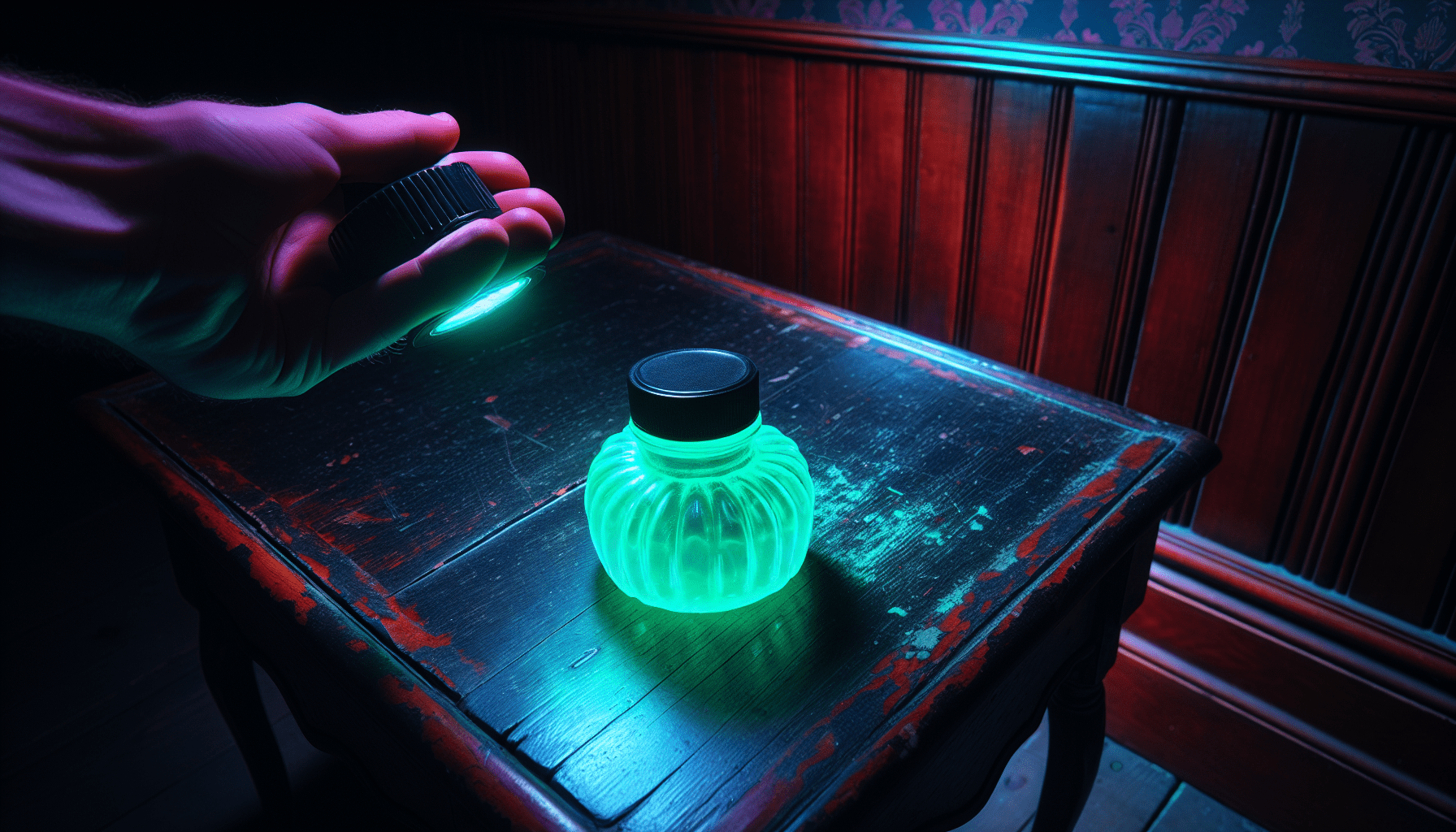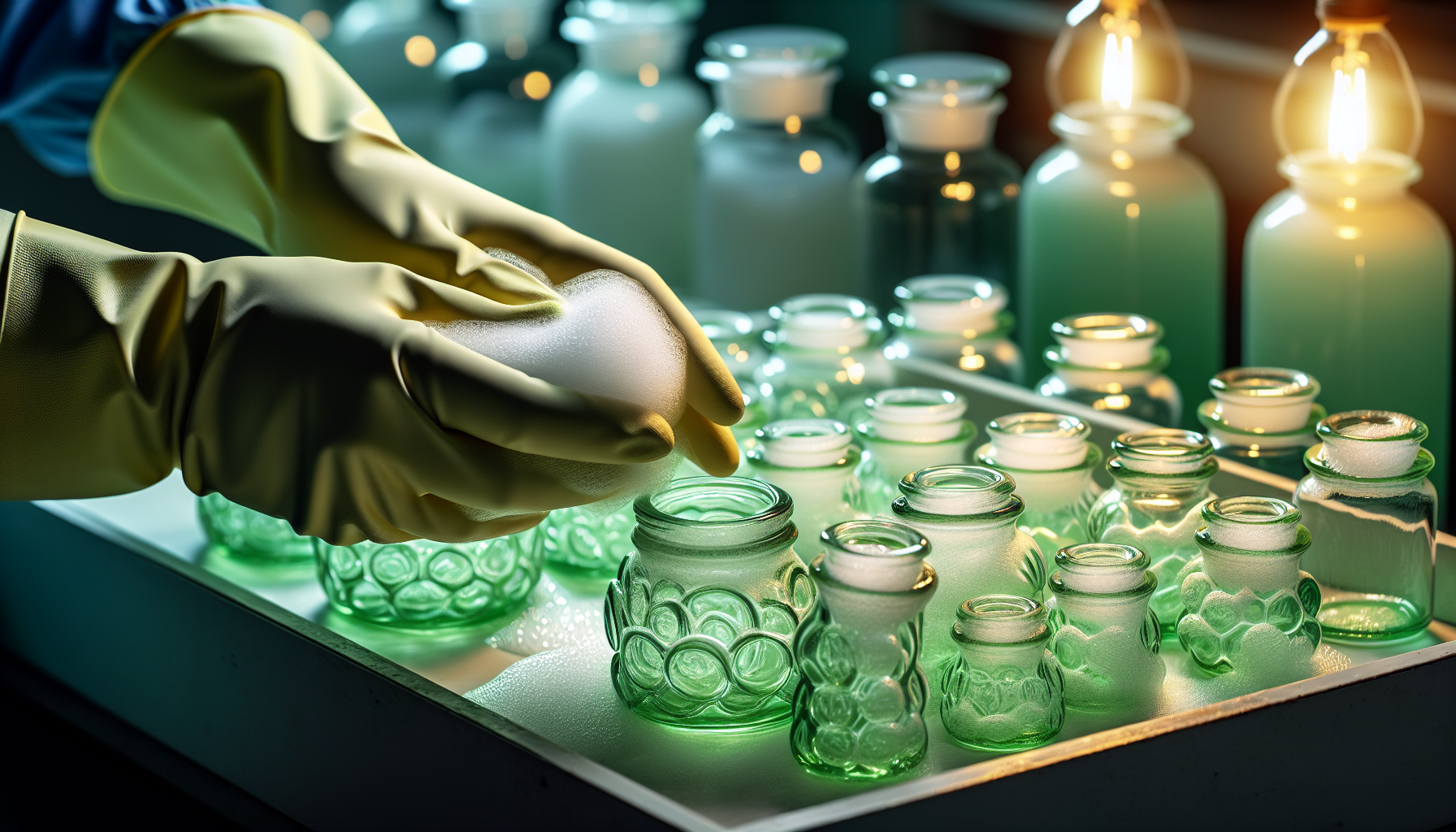Vaseline glass, known for its distinctive glow under ultraviolet light, captivates collectors and history enthusiasts alike. Embedded with uranium dioxide, it reveals a bright green fluorescence, distinguishing it from other antique glassware. This article dives into the characteristics, history, safety, and value of Vaseline glass, guiding you through the nuances of collecting and caring for these radiant pieces.
Key Takeaways
Vaseline glass, also known as canary glass, is uranium-infused and exhibits a unique neon green fluorescence under UV light, distinguishing it from non-uranium-based glass which glows differently or not at all.
The value of Vaseline glass as a collectible is influenced by factors including age, design, craftsmanship, rarity, and condition, with some pieces reaching significant market prices due to their unique characteristics and historical manufacturing.
While Vaseline glass contains low levels of radioactivity due to uranium content, it is generally considered safe to handle and display, with precautions taken not to ingest any material from the glass, especially in food or drink.
Exploring the Luminous World of Vaseline Glass

Glass known as Vaseline glass, acquiring its nickname from the similarity in color to petroleum jelly, captivates collectors with its vibrant yellowish-green appearance. This unique shade results from incorporating uranium dioxide within the glass composition. When exposed to UV light, this substance imparts a striking glow often referred to as ‘blacklight glow’ or ‘uranium glow,’ which is consistent with the definition given by VGCI and has been instrumental in bolstering its appeal among enthusiasts.
Burmese glass is part of an array of objects that fall under what’s considered Vaseline glass due to their shared characteristic hue ranging from yellow to green. Both functional wares and ornamental items fashioned out of this material not only exhibit aesthetic beauty but also embody a fascinating blend of creativity and scientific marvels—attributes well appreciated by those who collect them.
The Glow Factor: Uranium’s Role in Vaseline Glass
Incorporating uranium dioxide into glass gives it the unique ability to glow under ultraviolet light. This radiant phenomenon, commonly referred to as “uranium glow” or “blacklight glow,” occurs when UV rays stimulate the electrons within the material.
While in natural or artificial light without a UV source, Vaseline glass tends toward a yellow hue. When exposed to UV illumination—or sunlight—it reveals its signature green fluorescence. The intensity of this distinctive emission corresponds directly with the level of uranium present, which can vary from mere traces up to concentrations around 25%. To ascertain whether you have genuine uranium glass, examine how it responds under varied lighting situations — an approach that also helps establish its value on account of these distinct features.
True Vaseline Glass vs. Look-Alikes
In the realm of antique glass, it’s important to recognize that not every piece that emits a glow qualifies as Vaseline glass. True Vaseline glass is identifiable by its unique sheen, which can seem almost oily, and by its characteristic yellow or green hue when viewed in regular lighting conditions. This type of glass stands out from similar-looking opaque glasses because it allows light to penetrate through its semi-transparent form.
Thus, if you encounter a piece of glowing antique glass and are trying to establish whether it’s authentic Vaseline glass or not, checking for both the fluorescence under UV light—which should produce an unmistakable bright green radiance owing to uranium—and confirming that the piece isn’t opaque will be key indicators of authenticity.
The History of Vaseline Glass

Vaseline glass, which originated in the 1830s and was initially referred to as Annagruen in honor of its inventor Josef Reidel’s wife, carries a distinguished past. During the Victorian Era, it gained popularity as an ornamental material due to its fluorescent properties that were notably enhanced when exposed to UV light from contemporary arc lamps. Nevertheless, with the advent of electric lights replacing gaslight and kerosene lamps, the distinct luminescence of Vaseline glass became less visible thereby causing waning interest.
The term ‘vaseline glass’ came into use during the 1950s. Nevertheless, high uranium prices constrained ongoing production. The already limited production ceased entirely during World War II because uranium supplies were seized by authorities for government use.
From Victorian Curiosity to Modern Collectible
Vaseline glass, initially a Victorian-era novelty and now a sought-after collectible, has an intriguing history. It earned the moniker “vaseline glass” because its hue resembles that of Vaseline petroleum jelly. The distinctive luminosity this type of glass exhibits when exposed to the diverse light spectrums emitted by kerosene lamps made it extremely popular in the 1800s.
The charm of vaseline glass continues into contemporary times, captivating both collectors and historians who argue that true vaseline glass must be transparent and tinted only with uranium. No other colorants are considered acceptable for the piece to retain its authentic classification as vaseline.
Identifying Genuine Vaseline Glass Pieces

For collectors, the thrill lies in spotting true Vaseline glass items, which are distinguished by their unique characteristics.
A vivid green fluorescence when exposed to a blacklight due to its uranium content
In daylight, it has an oily sheen with a yellow-green hue
It boasts a semi-transparent look
Under UV light, it emits a neon green radiance
Authenticity of Vaseline glass hinges on its ability to exhibit this specific neon green illumination under ultraviolet light. Glass of different kinds may display various hues or more subdued luminosity when subjected to UV exposure.
The valuation of Vaseline glass is influenced by how pronounced its color shifts are. These shifts arise from varying amounts of uranium oxide mixed into the material and also depend on how thick each piece is made. The impact these factors have on value cannot be overstated. They impart singular qualities that enhance both uniqueness and desirability among those who seek such treasures.
Using Black Light to Confirm Authenticity
Ultraviolet light, often referred to as UV light or black light, plays a pivotal role in the verification process of Vaseline glass. When subjected to this kind of illumination, authentic Vaseline glass emits an unmistakable bright green radiance that sets it apart from other types of glass which may only show a green hue or lack any fluorescence. For collectors, possessing a black light flashlight is indispensable for highlighting the neon green luminescence and validating the genuineness of their treasures. Savvy collectors usually have a portable UV lamp at their disposal when searching for genuine pieces during shopping expeditions or collection searches.
Notably, although fluorescent glass bears resemblance to Vaseline glass due to its ability to glow under ultraviolet radiation — commonly known as black light — it can be identified separately by its milder and less vivid glimmer.
Health and Safety: Is Vaseline Glass Radioactive?
Despite the presence of uranium, which renders Vaseline glass marginally radioactive, it is largely deemed safe for handling and residential display if used correctly. A Geiger counter can detect its low-level radioactivity. To mitigate potential health hazards, consumption from Vaseline glassware should be avoided to prevent ingestion of radioactive substances. It’s also advisable to store this type of glass away from direct heat and sunlight so as not to amplify its radioactivity or cause the coloration to fade.
Vaseline glass emits a small amount of radiation similar in magnitude to what one might encounter during commonplace activities such as flying or using mobile phones. Yellow-green colored glass that bears resemblance with Vaseline varieties may still possess traces of radioactivity attributable to thorium impurities even when uranium isn’t present as a coloring agent. Due diligence regarding safety measures around handling materials containing uranium content has ensured that any risk associated with the minimal levels found in yellow green vaseline glasses remains nominal at best when properly managed.
Comparing Radiation Levels to Household Items
It is accurate to say that Vaseline glass contains uranium, making it radioactive. The emitted radioactivity is usually low. The radiation emanating from Vaseline glass tends to be less than what one might encounter when operating everyday electronic devices such as microwaves or computers. Ordinary items like smoke detectors and brazil nuts actually contain radioactive substances that can release more intense levels of radiation than those found in Vaseline glass.
Though it possesses a degree of radioactivity, Vaseline glass poses minimal danger and can be safely utilized and exhibited within residential settings.
The Value of Vaseline Glass in Today’s Market
The value of Vaseline glass in the current market is significantly determined by a range of factors including its age, design, artisanship, scarcity, and state of preservation. The valuation of Vaseline glass is affected by:
Its historical period
The uniqueness or artistic flair of its design
Quality and detail in craftsmanship
Its level of rarity
The overall condition
Particularly rare items, especially those produced by renowned companies such as Fenton Art Glass Company, can have their value markedly increased due to their limited availability among collectibles.
Regarding pricing for these pieces – it varies greatly with some fetching less than £100 while others might command prices exceeding £10,000. This variation highlights the broad appeal and collectibility factor that come into play given the complexity and notable origins associated with each piece’s creation.
Where to Find Vaseline Glass for Your Collection
For enthusiasts keen on initiating or expanding their Vaseline glass collection, there are numerous venues to uncover these distinctive items. Often unaware of the true value of Vaseline glass, thrift stores and charity shops might offer such pieces at a bargain. Vintage stores represent another haunt for collectors seeking out rare finds from defined eras.
Alternatively, auctions and internet platforms extend the possibilities for discovering Vaseline glass by presenting an extensive array of options across diverse regions and vendors. Recognizing marks from manufacturers such as Mosser or Fenton can aid collectors in securing authentic contemporary Vaseline glass treasures.
Caring for Your Vaseline Glass Collection

To maintain the allure and condition of your collection of Vaseline glass, it is essential to care for and clean these pieces correctly. Here’s what you should do:
To cleanse regularly, opt for a soft, lint-free cloth or a non-abrasive glass cleaner to avoid marring the surface.
If there are marks or grime present, delicately wipe the glass with a dampened soft cloth along with a gentle detergent mix.
After cleaning, make sure you rinse off all soap residue completely and dry out each piece meticulously in order to forestall any watermarks.
By adhering to this guidance diligently, you can ensure that your Vaseline glass remains in prime condition.
Should storage be necessary for your items of Vaseline glassware: swathe them up carefully using either smooth tissue paper or some type of protective fabric as safeguards against scrapes or other potential harm. Adopting such straightforward measures reliably will ensure that they sustain their enchanting luminescence indefinitely.
Displaying Your Glowing Treasures
Crafting an elegant display for Vaseline glass is about capturing its radiant charm optimally. The subtle yet unique glow of Vaseline glass comes to life when hit by UV light, especially during the soft glimmers at twilight. To emphasize the brilliant fluorescence of this special glass, position it where daylight can grace its surface or adjacent to windowpanes. For a more pronounced effect in darker environments like a cabinet setup, consider employing LED black lights to draw out its luminescence.
Assemble your collection of Vaseline glass thoughtfully—whether that be sorting by hue or form—to establish an aesthetically pleasing arrangement that accentuates pieces with shared characteristics. Using backdrops or shelving in hues that complement those within the Vaseline glass enhances its incandescent qualities even further. Beyond mere display, incorporating these items into practical elements of home decor invites admiration and enjoyment through everyday use.
The Cultural Impact of Vaseline Glass

Vaseline glass has left a notable mark on culture, with its importance spanning from the Great Depression to modern-day interest from collectors and historians. Throughout the financial hardships of the Great Depression, Vaseline glass provided an accessible touch of extravagance, lifting people’s moods with its unique green shine when exposed to UV light—a quality that greatly contributed to its desirability.
Presently, this same type of glass captivates both historians and collectors who appreciate it as a symbol reflecting diverse artistic and industrial trends through different periods.
Vaseline Glass During the Depression Years
In the face of economic challenges presented by the Great Depression, families sought cost-effective substitutes for essential items and simple indulgences. Glassware infused with Vaseline was a budget-friendly choice that delivered an air of sophistication and continuity in difficult times. The distinctive glow of this glass brought vibrancy and flair to domestic articles, enabling households to preserve an atmosphere of elegance within their means.
Although it comprised uranium, Vaseline glass became embedded in daily routines as society embraced its use for common products such as table settings throughout this period. This reflects how deeply ingrained and normalized it had become despite its composition during those trying years.
Beyond Vaseline Glass: Related Collectibles
The world of vintage glassware includes a variety of unique items to Vaseline glass. Enthusiasts prize these antique glasses for their distinct characteristics, including the fascinating radioactive green glow emitted by Uranium Glass and the accessible price point that made Depression Glass so popular.
Although it can be confused with Vaseline glass due to its resemblance, Depression Glass does not exhibit a green luminescence when exposed to UV light. It is distinguished by elaborate patterns and designs and comes in an array of hues like pink, green, blue, and amber.
Custard Glass: The Creamy Cousin
Custard Glass, a variety of antique glass, is sometimes described as the opaque counterpart to Vaseline glass. This type of glass stands out for its soft, milky quality that distinguishes it from the translucent and brightly colored Vaseline version. Both are characterized by their content of uranium oxide, which gives them uniqueness in appearance.
First produced by Sowerby in England before expanding across Europe during the latter part of the 19th century, Custard Glass articles typically featured gold trimmings and were created as commemorative pieces representing various travel locations or important occurrences dating back to around the early 1900s.
Summary
As we conclude our examination of Vaseline glass, it’s clear that this fascinating substance has successfully woven together elements of artistry, scientific curiosity, and historical significance. Characterized by its luminous reaction to UV light due to its uranium content— a trait that gained popularity in the era surrounding the Great Depression — Vaseline glass continues to enchant both collectors and history enthusiasts. Although it contains radioactive material, the risk is very low, allowing for safe use and display within households. The evolution of Vaseline glass from an object of Victorian fascination into a sought-after collectible item today demonstrates its lasting charm. Value greatly impacted by age, design exclusivity, scarcity, and condition preservation. For those immersed in collecting or just starting out on their discovery journey, Vaseline glass presents a radiant tapestry waiting to be delved into.
Frequently Asked Questions
What is special about Vaseline glass?
When vaseline glass comes into contact with UV light, it exhibits a distinctive green glow, a result of containing uranium dioxide ranging from 0.1% to 25%. This characteristic sets it apart from other varieties of glass.
Is Vaseline glass worth any money?
Certainly, the value of Vaseline glass may range from $20 to $50, with its worth being influenced by aspects like rarity and condition. When assessing its value, it’s important to take into account how rare the piece is and in what state it currently exists.
Does anyone still make Vaseline glass?
Certainly, a handful of manufacturers continue to produce Vaseline glass today, including Boyd’s Crystal Art Glass, Fenton Glass, Mosser Glass, Gibson Glass and Jack Loranger.
The production of this type of glass was halted during the period surrounding World War II. From 1942 until 1958, the confiscation of uranium supplies led to a cessation in manufacturing.
How do you identify Vaseline glass?
When using a black light to determine if a piece of glass is Vaseline glass, look for the distinct neon green glow it emits upon illumination. The absence of a green glow indicates that the item in question is not Vaseline glass.
Is Vaseline uranium glass safe?
Indeed, Vaseline uranium glass can be safely interacted with and kept in proximity because it presents no danger due to its minimal radioactive characteristics, whether touched or swallowed.

